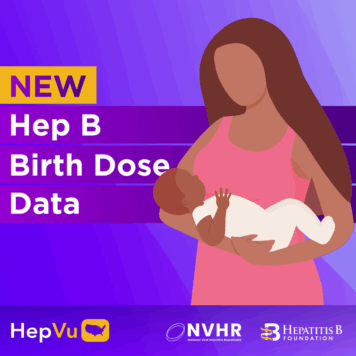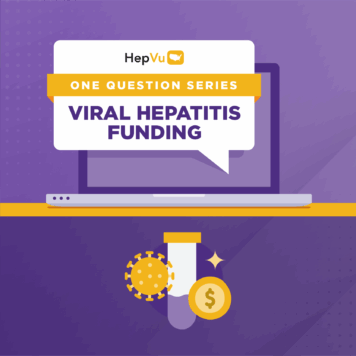Kate Moraras is the Deputy Director of Public Health at the Hepatitis B Foundation and the Director of Hep B United.
Q: You currently work as Deputy Director of Public Health at the Hepatitis B Foundation and as the director of Hep B United. How did you first become involved in Hepatitis B and how has the field changed in recent years?
When I first started working in the Hepatitis B field, I was on a fellowship at the Office of Minority Health with the Department of Health and Human Services. I was already familiar with Hepatitis B and understood that it was the single greatest health disparity for Asian Americans and Pacific Islanders at the time. I became more engaged with this issue over time and eventually made my way to the Hepatitis B Foundation. Coincidentally, when I started with the foundation, I learned that I had an uncle who is living with Hepatitis B. Ever since, my professional dedication to Hepatitis B knowledge and engagement became more personal.
In recent years, conversations about Hepatitis B have evolved. Originally, Hepatitis B was generally known as an Asian American health issue since more than half of chronic Hepatitis B cases in the U.S. are amongst Asian Americans and Pacific Islanders (who only make up about 6% of the U.S. population). However, in the past 6 years or so, Hepatitis B infections have steadily climbed amongst rural communities and younger populations – primarily due to injection drug use tied to the opioid epidemic. All this considered, I believe that Hepatitis B needs to be seen in the context of racial discrimination to align with the social justice conversations we’re having today. We have started to highlight these realities and are seeing prioritization of messages that encourage testing to address the gaps in adult hepatitis B vaccination rates.
Q: On May 5, the U.S. Preventive Services Task Force (USPSTF) released a draft recommendation statement, which recommends Hepatitis B screenings for adolescents and adults at increased risk for infection. In response to this draft rule, Hep B United and the Hepatitis B Foundation sent a letter urging the USPSTF to expand its recommendation to endorse universal Hepatitis B screenings for all adults. Why do you think that the current USPSTF risk-based Hepatitis B screening recommendation falls short?
These new screening guidelines are not effective. The Hepatitis B community is disappointed to see that the task force put out a recommendation that was quite similar to what has been in place since 2014, and did not encourage universal screening of all adults for Hepatitis B. Six years have passed, but we are not seeing the necessary changes being made. The USPSTF statement also mirrors what the CDC has been recommending for ten years: people who are high-risk should get screened. We have evidence that this is not enough. Estimates show that up to 75% of Hepatitis B-infected individuals remain undiagnosed. I think it’s time that we look at a universal screening recommendation because there are clearly gaps in risk-based screening.
Additionally, the list of current populations with Hepatitis B screening recommendations include U.S. born persons with parents from a region with high prevalence, people living with HIV, injection drug users, and men who have sex with men. Each of these groups carries a certain stigma attached to them and may not always disclose to healthcare professionals that they are at risk for Hepatitis B. Therefore, we have issues on both the provider-side and the patient-side when trying to make Hepatitis B a routine condition to screen.
Currently, screening for a Hepatitis B infection is not routine in our healthcare system. For example, we’ve heard from healthcare providers in Philadelphia that they are not screening for Hepatitis B because they don’t have the resources, knowledge, or the capacity to treat it. We have also heard from providers that the screening recommendation is too difficult to implement in our healthcare settings. For instance, one of the screening recommendations include those who were born in a region or country with high or intermediate levels of endemic Hepatitis B infections. However, an individual’s country of birth is often poorly captured in electronic medical record systems or difficult to capture in a questionnaire. If you compare that to the previous Hepatitis C testing recommendation for Baby Boomers, this is more effective because an individual’s age is more often captured accurately. Looking for a specific country of birth is more challenging to implement. You might be able to capture with language or preferred language, but that’s also missing a large proportion of people.
Q: The current USPSTF recommendation for Hepatitis B screenings is classified as a grade “B” recommendation. However, Hep B United is pushing for USPSTF to elevate their screening recommendation for Hepatitis B to a grade “A.” Can you speak to the functional difference between a grade A and grade B recommendation and how this would impact the uptake of Hepatitis B screening?
The USPSTF defines the A grade as a preventive service that has a high degree of certainty that the benefit is substantial based on the reviewed evidence. Whereas with a B grade, there is a high degree of certainty that the benefit is moderate. As far as functionality, both the A and B grade translates to recommending the provider perform the preventive service, which in this case is screening.
The grade also mandates insurance coverage. When the Affordable Care Act (ACA) was passed it mandated that insurance automatically covers grades A and B recommended screenings without cost to the patient. If Hepatitis B had a grade A screening recommendation, this would amplify and create an urgency of the importance of screening for Hepatitis B infections for both providers and patients.
If you compare Hepatitis B to HIV, which has an A grade, you can see that we’re dealing with a very similar epidemic. Hepatitis B also has no cure, but it has highly effective treatments that can reduce viral load and even vaccines that can prevent infection and offer lifelong protection. However, Hepatitis B screenings are still only recommended to certain groups of people. It’s all about sending the message that this deserves to be elevated.
Q: An estimated 2.2 million people are living with Hepatitis B in the United States, yet between 65% and 75% of those cases are currently undiagnosed. How would universal screening recommendations help lower this percentage?
If we were able to screen all adults across the board, we would be able to eliminate the confusion about who to screen. We would see Hepatitis B screenings being prioritized within healthcare systems, which would eventually lead to a decrease in the percentage of undiagnosed individuals. We need to make sure Hepatitis B preventative services are offered as a part of all routine healthcare.
Q: How does risk-based screening potentially impact Hepatitis B-associated stigma? How can universal Hepatitis B screening help to reduce the stigma associated with Hepatitis B infection?
I think risk-based screening exacerbates the stigma that already exists and is prevalent among many foreign-born Asian American and African communities. These are cultures that already face multiple barriers to healthcare access, anxiety, and racial discrimination, especially in the current environment of COVID-19. Living with Hepatitis B can mean being shunned from your community. Through our #justB storytelling campaign, we’ve heard from individuals who are not able to share meals and be at the same table with their families or were unaware a family member had passed away from Hepatitis B complications because the family refused to talk about it.
In a video for the #justB storytelling campaign, Alan Wang, a newscaster and person living with Hepatitis B, said:
“We were left to connect the dots because the medical profession is failing to address an epidemic that kills more than 700,000 people a year. It’s also ignored by Asian cultures that consider talking about deadly diseases a taboo. Sometimes I wonder if Hepatitis B is being ignored here in the U.S. just because it impacts so many Asians, especially given the country’s history of discrimination towards immigrants.”
I think Alan really nailed it in terms of how he and many others feel about this epidemic. I think that risk-based screening is targeting groups of individuals that are already labeled unfairly. If you look at people living with HIV or injection drug users, these communities are already dealing with an associated stigma. These stigmas are hard to capture for healthcare providers because people sometimes don’t feel comfortable discussing it in traditional clinical settings. Moving to universal screenings for all adults without flagging certain risk behaviors and labels will absolutely help to reduce stigma.
Q: The opioid epidemic has substantially increased Hepatitis B incidence especially in those states heavily impacted by the opioid epidemic. Can you explain how our current system has led to missed opportunities to identify populations at risk? Are there also opportunities to utilize universal screening to address issues such as HBV vaccine coverage in states with high opioid use?
Populations at risk for Hepatitis B include those who are HIV positive, persons who inject drugs, and men who have sex with men. However, Hepatitis B screenings are not prioritized or routinely integrated in harm reduction programs or drug treatment programs, such as syringe service programs. We certainly see more of a provider emphasis on screenings for HIV or Hepatitis C – just not for Hepatitis B. We are missing an opportunity to incorporate Hepatitis B testing in settings where treatment (or referral to care) and vaccination is possible. There are screenings for other diseases that are a consequence of the opioid epidemic in the country, so why not Hepatitis B?
We have been looking to partner with harm reduction programs. For example, the Pennsylvania Harm Reduction Coalition just joined our national coalition, Hep B United. We’re starting to make connections and hear from organizations around the country that are asking for technical assistance because they don’t normally test for Hepatitis B. To be fair, Hepatitis B testing is more complicated. It requires a blood draw and a three-part panel. But we are trying to provide more assistance where we can, so that we’re not missing that portion of the population.
In terms of the opportunity, the opioid epidemic has definitely revealed the low vaccination rates amongst adults in the U.S. Currently only 25% of the adult population has completed the Hepatitis B vaccine series. Everyone should be screened first. If we are proactive, we can determine if someone is vulnerable and get them vaccinated.




